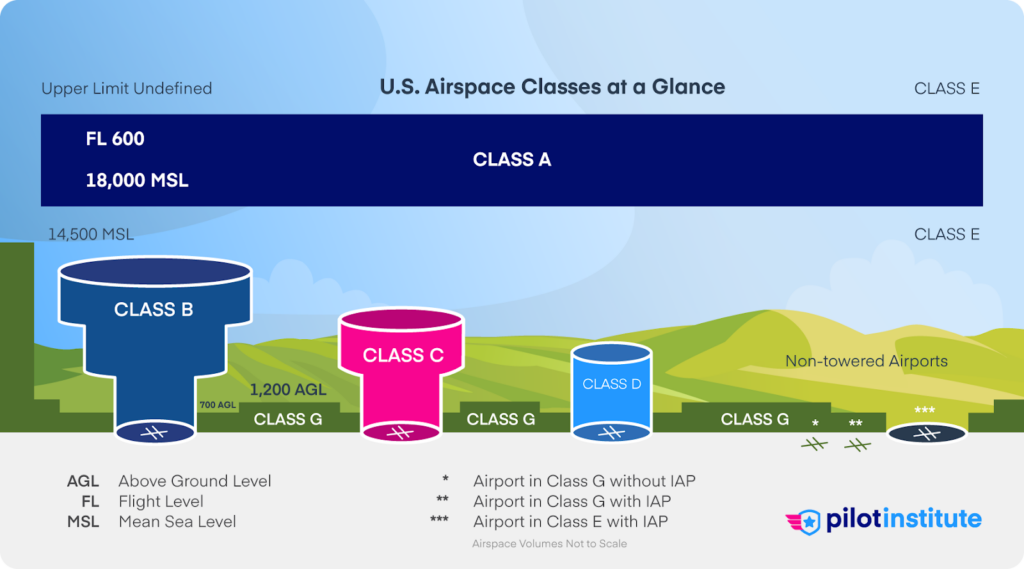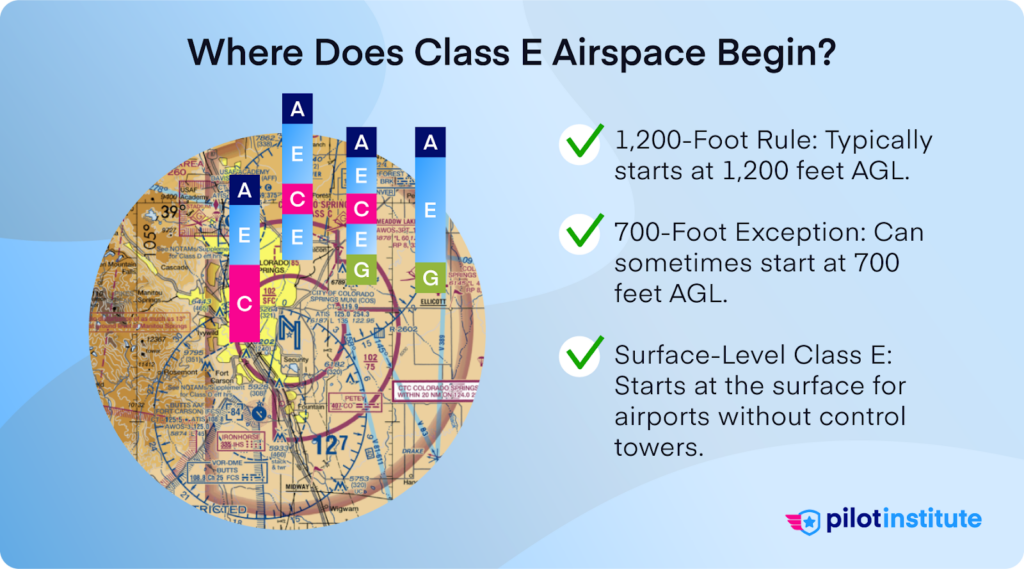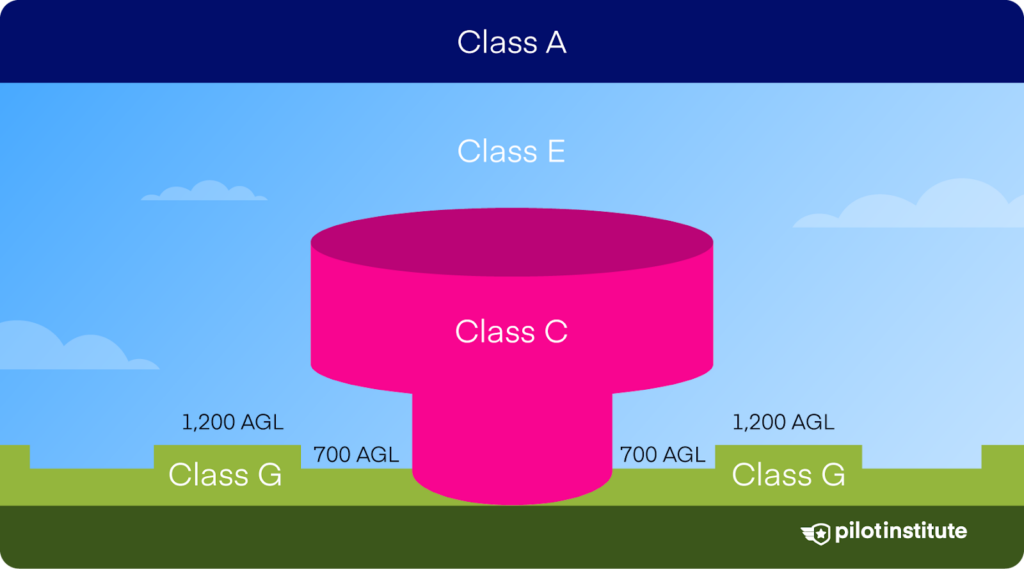-
Key Takeaways
-
Introduction to Class E Airspace
-
Where Does Class E Airspace Begin?
- The 1200-Foot Rule
- The 700-Foot Exception
- Surface-Level Class E
-
Class E Airspace Dimensions
- Vertical Limits
- Horizontal Spread
- Special Configurations
-
Weather Minimums for Class E
- Below 10,000 feet MSL:
- At or Above 10,000 feet MSL:
- Remember the Cessna 3-152 Rule
-
Purpose and Functions of Class E Airspace
- Balanced Airspace
- Buffer Zone
- Victor Airways
- Transition Into Airspaces
- Reversions: When Airspace Changes
-
Conclusion
Class E airspace covers more of the skies than you might think. Because it’s so widespread, some pilots casually refer to it as ‘Class Everywhere,’ though this is not an official term.
You don’t need to check in with Air Traffic Control (ATC) when flying VFR in Class E. But, it has a structure and purpose. It helps separate traffic at different altitudes.
Class E is always in the background, making sure both VFR and IFR traffic can coexist in safety.
Let’s break down what makes this airspace unique. You’ll need to understand its boundaries and rules. They’re more important than you might think.
Key Takeaways
- Class E airspace is the most common controlled airspace in the United States.
- It typically begins at 1200 feet AGL but can start lower in some locations.
- No ATC clearance is generally required for standard VFR flights in Class E airspace
- Use the Cessna 3-152 mnemonic to remember weather minimums for VFR.
Introduction to Class E Airspace

Class E airspace is the most common type of controlled airspace. This airspace provides ATC services to all IFR aircraft and VFR traffic upon request. You can think of Class E as the ‘default’ controlled airspace – anywhere not defined as a different Class of airspace.
Unlike Classes B, C, and D, Class E generally does not require two-way radio communication or a transponder for VFR flight, unless you’re above 10,000 feet MSL or inside certain Mode C veils.
Specific equipment like transponders and ADS-B Out become required at and above 10,000 feet MSL (with some exceptions).
Think of Class E as the middle child of the airspace family. It’s not as strict as Class A, B, C, or D, but it’s more structured than Class G. It’s the airspace you will spend most of your flying time in.
Why do you need to learn about Class E airspace? If you are a student pilot who plans on flying their first solo cross-country or a veteran pilot going on a trip, learning how to navigate via Class E airspace is a must.
However, many pilots find Class E airspace confusing because of the different types of altitudes and markings on the sectional chart. We will show you how to identify the airspace in the next section.
Where Does Class E Airspace Begin?

Let’s talk about where Class E airspace begins. The answer? Almost everywhere, but at different altitudes.
The 1200-Foot Rule
Usually, Class E airspace starts at 1200 feet Above Ground Level (AGL). This is the most common configuration. Many states have large areas of Class E starting at 1200 feet, shown by a blue fuzzy line on the sectional chart.
The 700-Foot Exception
In some cases, Class E can begin as low as 700 feet AGL to offer support for instrument approaches. These are commonly referred to as transition areas. On sectional charts, you can find Class E starting at 700 feet in areas located inside a faded magenta shape.
Surface-Level Class E
Sometimes, Class E airspace can start from the surface in airports with instrument approaches but no control tower. You can easily identify this airspace on the map by looking for a dashed magenta circle around the airport.
Class E Airspace Dimensions

As a pilot, you must understand Class E airspace and its dimensions. Generally, if you’re not in Class A, B, C, D, or G airspace, you’re flying in Class E. Remember the key to navigating Class E is to check your sectional charts.
Let’s take a look at Class E dimensions:
Vertical Limits
Vertically, Class E airspace can begin at various altitudes such as the surface, 700 feet AGL, 1,200 feet AGL, or 14,500 feet MSL. It generally extends up to, but does not include, 18,000 feet MSL.
At 18,000 feet, the airspace transitions into Class A.Class E resumes again above 60,000 feet MSL (FL600). Keep in mind, this airspace is rarely used by general aviation, and above 60,000 ft is higher than commercial airliners fly.
Horizontal Spread
Class E airspace is not standardized in terms of shape or size laterally. The airspace covers large areas of most of the United States. In rural or less congested areas, Class E is often the most common controlled airspace you’ll encounter.
Special Configurations
Class E can take on different configurations. In some places, you might find corridors of Class E airspace that connect to other areas. These spaces often align with instrument flight routes.
Why this structure? The lower layers (700 or 1200) of Class E offer safer IFR operations and allow VFR flights to operate with fewer restrictions. The airspace above FL600 (60,000 feet MSL) is designated as Class E airspace.
Note: Before you take off, review your sectional charts so you know exactly where Class E starts and where it ends along your planned route.
Weather Minimums for Class E

The VFR weather minimums in Class E airspace change based on your altitude:
Below 10,000 feet MSL:
- 3 Statute Miles (SM) visibility
- 1000 feet above clouds
- 500 feet below clouds
- 2000 feet horizontal from clouds
At or Above 10,000 feet MSL:
- 5 SM visibility
- 1000 feet below clouds
- 1000 feet above clouds
- 1 SM horizontal from clouds
Why these specific numbers? They allow you enough clearance to see and avoid other airplanes. These weather minimums exist to prevent you from flying into clouds if you are not an instrument-rated pilot.
At altitudes over 10,000 feet MSL, the visibility minimums go up from 3 to 5 SM to give you more time to react. At this altitude, commercial airlines and high-speed aircraft move in and out of the clouds.
Keep in mind that these are minimums. In many cases, it is useful to have more spacing from the clouds, especially if you are a Student Pilot.
Remember the Cessna 3-152 Rule
An easy way to remember the VFR weather minimums for Class E airspace below 10,000 feet is to use the mnemonic ‘Cessna 3-152’:
- 3 SM visibility.
- 1,000 ft above.
- 500 ft below.
- 2,000 ft horizontal from clouds.
Purpose and Functions of Class E Airspace
Class E airspace has an important purpose in the National Airspace System. Class E airspace has fewer restrictions, and you can freely fly in the airspace as long as you follow the flight rules of IFR or VFR. Let’s look at some of the functions of Class E.
Balanced Airspace
Class E airspace provides a safe balance for IFR and VFR flights. Most importantly for VFR operations, clearance is generally not required, nor is mandatory communication with a controller in most Class E airspace.
Keep in mind, it is the VFR pilot’s responsibility to ‘see and avoid’ other aircraft, and participation in ATC services like flight following is encouraged.
Buffer Zone
Think of Class E as a buffer between the busy, controlled airspace near airports and the uncontrolled Class G airspace. It’s a zone where you can gradually adjust to different rules and procedures.
Victor Airways
Many low-altitude Victor Airways, also known as highways in the sky, run through Class E airspace. These airways are often defined by reference to VOR navaids.
The total width of these airways is usually 8 Nautical Miles (NM). These airways help guide IFR and VFR aircraft from one navaid/VOR to another.
Transition Into Airspaces
Often, Class E airspace acts as a transition zone into other airspaces. For example, when descending from Class A airspace, you must pass through Class E before entering Class B, C, or D.
Reversions: When Airspace Changes
A fun fact about Class E airspace is that it can change its classification based on certain conditions. For instance, in small airports with part-time control towers, the airspace changes from Class D to Class E after the tower closes.
Conclusion
You may not think much about Class E airspace. But, if you fly at common general aviation altitudes, such as from 700 feet AGL up to (but not including) 18,000 feet MSL, you’re likely in it.
Class E airspace generally has pretty straightforward requirements for VFR flight. But these change if weather conditions start to deteriorate below standard VFR minimums within a Class E surface area. Then you require an ATC clearance for Special VFR.
Requirements also become tighter when flying at or above 10,000 feet MSL, with higher VFR weather minimums and specific equipment mandates
Next time you’re scanning a sectional, those faded magenta vignettes might just stand out a little more.
If you want to deepen your knowledge of airspace, check out Airspace Classes Explained.



